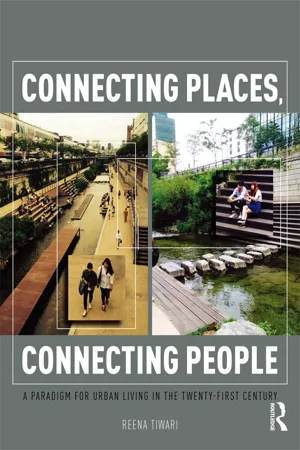
Connecting Places, Connecting People
A Paradigm for Urban Living in the 21st Century
Reena Tiwari
- 170 pages
- English
- ePUB (mobile friendly)
- Available on iOS & Android
Connecting Places, Connecting People
A Paradigm for Urban Living in the 21st Century
Reena Tiwari
About This Book
What is a better community? How can we reconfigure places and transport networks to create environmentally friendly, economically sound, and socially just communities? How can we meet the challenges of growing pollution, depleting fossil fuels, rising gasoline prices, traffic congestion, traffic fatalities, increased prevalence of obesity, and lack of social inclusion?
The era of car-based planning has led to the disconnection of people and place in developed countries, and is rapidly doing so in the developing countries of the Global South. The unfolding mega-trend in technological innovation, while adding new patterns of future living and mobility in the cities, will question the relevance of face-to-face connections. What will be the 'glue' that holds communities together in the future?
To build better communities and to build better cities, we need to reconnect people and places. Connecting Places, Connecting People offers a new paradigm for place making by reordering urban planning principles from prioritizing movement of vehicles to focusing on places and the people who live in them. Numerous case studies, including many from developing countries in the Global South, illustrate how this can be realized or fallen short of in practical terms. Importantly, citizens need to be engaged in policy development, to connect with each other and with government agencies. To measure the connectivity attributes of places and the success of strategies to meet the needs, an Audit Tool is offered for a continual quantitative and qualitative evaluation.
Frequently asked questions
Information
PART I
The Concept
Note
References
C H A P T E R 1
CONNECTING PLACES, CONNECTING PEOPLE
Why do we travel? Isn’t it to access places so that we can directly manage our everyday affairs? Isn’t it to connect with other people?
Connecting [with] people, getting things done–that’s what makes the travel worthwhile.(Tim Finchem, quoted in Shipnuck, 2011)
The Crisis
The Great Crawl of China … Thousands of motorists have been caught up in a 60-mile tailback since August 14–an incredible 11 days ago. And it could last a further three weeks. While many motorists took detours, some ended up trapped for up to five days, sleeping in their cars and taking shifts behind the wheel … 400 police were drafted in to ensure the communal road rage was kept in check.(Bates, 2010)
Urban Reconfiguration
Table of contents
- Cover
- Half Title
- Title Page
- Copyright Page
- Table of Contents
- List of Illustrations
- Acknowledgments
- Prologue
- Foreword by Professor Peter Newman
- Part I: The Concept
- Part II: Mapping the Context: Urban Reconfigurations
- Part III: Connecting Places, Connecting People: Making it Happen!
- Part IV: The Future
- Epilogue: Ethnography of Place and Movement
- Index